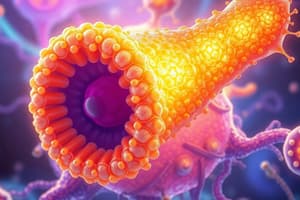Podcast
Questions and Answers
What is the primary function of the rough endoplasmic reticulum?
What is the primary function of the rough endoplasmic reticulum?
- DNA replication
- Energy production
- Lipid synthesis
- Protein synthesis and modification (correct)
Smooth ER is characterized by the presence of membrane-bound ribosomes.
Smooth ER is characterized by the presence of membrane-bound ribosomes.
False (B)
What role does the Golgi apparatus play in the cell?
What role does the Golgi apparatus play in the cell?
Processing and packaging cellular constituents
The nucleus is a double-membraned organelle containing ____ material.
The nucleus is a double-membraned organelle containing ____ material.
Match the following cell organelles/functions with their descriptions:
Match the following cell organelles/functions with their descriptions:
What is the primary function of the nucleolus?
What is the primary function of the nucleolus?
Ribosomes are only found in eukaryotic cells.
Ribosomes are only found in eukaryotic cells.
What is commonly referred to as the powerhouse of the cell?
What is commonly referred to as the powerhouse of the cell?
The nucleolus is found within the cell's _____ and is responsible for ribosome production.
The nucleolus is found within the cell's _____ and is responsible for ribosome production.
Match the following cellular components with their functions:
Match the following cellular components with their functions:
Flashcards are hidden until you start studying
Study Notes
Golgi Apparatus and Endoplasmic Reticulum
- The Golgi apparatus processes a variety of cellular substances along the secretory pathway.
- Rough endoplasmic reticulum (rough ER) synthesizes, folds, and modifies proteins for delivery to organelles or secretion.
- Rough ER responds to unfolded proteins and is linked to apoptosis via interaction with mitochondria.
- It is distinguished by membrane-bound ribosomes visible under a microscope.
- Smooth endoplasmic reticulum (smooth ER) is tubular, lacking ribosomes, and primarily manufactures lipids.
- In liver cells, smooth ER assists in breaking down glycogen into glucose.
- Smooth ER also produces steroid hormones in adrenal cortex and endocrine glands.
Nucleus and Nucleolus
- The nucleus is a double-membraned organelle containing genetic material, regulating cellular activities such as metabolism and division.
- It is crucial for categorizing cells as prokaryotic (no nucleus) or eukaryotic (true nucleus).
- The nucleolus, found within the nucleus, produces and assembles ribosomes and does not contain chromosomes.
- It accounts for approximately 25% of the nucleus's volume and consists of fibrillar centers where ribosomal proteins are formed.
Ribosomes
- Ribosomes are molecular machines for protein synthesis, composed of rRNA and proteins (ribonucleoprotein).
- They consist of two subunits: smaller and larger, and can be free in the cytoplasm or attached to rough ER.
- Essential for all living cells to produce proteins, ribosomes differ in size between prokaryotic (70S) and eukaryotic (80S) cells.
Mitochondria
- Mitochondria are membrane-bound organelles generating chemical energy for cellular reactions.
- They contain their own small chromosomes, highlighting their role in energy metabolism.
Bacterial Conjugation and Cell Division
- Bacterial conjugation is a direct genetic transfer mechanism between bacterial cells requiring contact.
- Eukaryotic cell division through meiosis reduces chromosome number in gametes, while prokaryotic cells divide via binary fission.
Cell Structure: Prokaryotic vs. Eukaryotic
- Prokaryotic cells range from 0.1 to 5.0 micrometers, lacking a true nucleus and membrane-bound organelles.
- Eukaryotic cells range from 10 to 100 micrometers, which contain a true nucleus and various organelles.
- Eukaryotic cell walls are complex (cellulose), while prokaryotic walls are simpler (peptidoglycan).
- Eukaryotic cells possess a cytoskeleton, whereas prokaryotic cells do not.
Cellular Differentiation and Growth
- Stem cells can differentiate into specialized cell types like muscle or nerve cells depending on microenvironment signals.
- Animal cells increase in size by accumulating cytoplasm and organelles, while plant cells expand through water uptake in vacuoles.
- Turgor pressure from vacuoles causes plant cells to swell and enlarge.
Cell Division Mechanisms
- In plant cells, a cell plate forms from Golgi-derived vesicles during cytokinesis, ultimately dividing the cell.
- Glyoxysomes, found in plant cells, are involved in lipid metabolism and convert stored lipids into carbohydrates, especially in seeds.
- Animal cells primarily rely on mitochondria for energy production, differing in metabolic processes from plants.
Studying That Suits You
Use AI to generate personalized quizzes and flashcards to suit your learning preferences.




